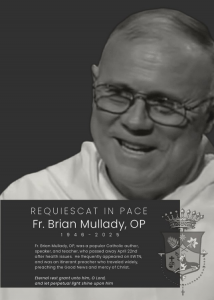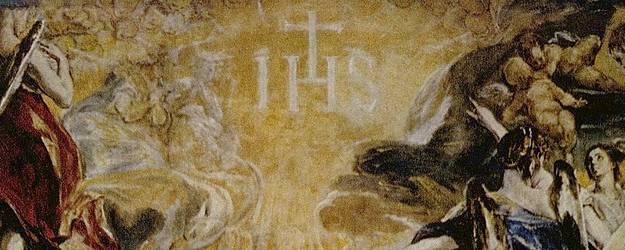 In Memoriam: Fr. Brian Mullady, O.P.
In Memoriam: Fr. Brian Mullady, O.P.
We at Homiletic and Pastoral Review mourn the passing of Rev. Brian Thomas Becket Mullady, O.P., STD. Fr. Brian was a noted theologian, preacher, author, and professor. For many years, Fr. Brian was an associate editor of HPR, writing the Question and Answers column. His clarity, erudition, and exemplification of Veritas made Fr. Brian a joy for us to know and to work with in our journal. May God reward him with the Lumen Gloriae. Our editor-in-chief, Fr. John Cush, will offer Holy Mass for the repose of the soul of Fr. Brian, OP, in the chapel at Saint Joseph Seminary and College, Dunwoodie, New York, on Friday, May 2, 2025.
Do Others in Scripture Have Jesus’ Name?
Question: Dear Father, were there other Jesuses in the Bible besides Our Lord?
Answer: Thank you for your question. Yes, in fact there were, as the name “Jesus” (or Yeshua in Hebrew) was not unique to Jesus of Nazareth; it was a common name in the ancient Jewish world, meaning “Yahweh saves” or “The Lord is salvation.” In the Bible, there are other individuals with the same name or closely related names.
In the Old Testament, Joshua was Moses’ successor who led the Israelites into the Promised Land. He was mentioned extensively in the Old Testament, particularly in the Book of Joshua. The Hebrew name Yehoshua (Joshua) is linguistically the same as Yeshua, the Aramaic form of Jesus’ name.
Joshua (Yeshua) the High Priest was a post-exilic high priest who helped rebuild the Temple after the Babylonian exile. He was mentioned in Ezra 3:2 and Zechariah 3:1–10 and he is portrayed in Zechariah as a symbolic figure of God’s redemption, foreshadowing Christ’s priestly role.
In the New Testament, we will find in addition to Our Lord, Jesus (Justus) in the New Testament who was a Christian associate of the Apostle Paul. Colossians 4:11 briefly mentions him as a fellow worker in spreading the Gospel. Though sharing the name “Jesus,” this individual is clearly distinguished from Jesus of Nazareth.
Surprisingly, there is some evidence that Barabbas may have been called “Jesus Barabbas” in certain ancient texts of the New Testament, though this is not always reflected in modern translations. Some early Greek manuscripts of the Gospel of Matthew (27:16–17) include the name “Jesus Barabbas.” In these versions, Pilate asks the crowd: “Whom do you want me to release to you: Jesus Barabbas or Jesus who is called the Messiah?” However, in many later manuscripts, the name “Jesus” is omitted for Barabbas, likely because scribes were uncomfortable with the idea of the name “Jesus” being associated with a criminal.
Barabbas means “son of the father” (Bar = son, Abba = father). If his full name was “Jesus Barabbas,” it would create an interesting juxtaposition between two figures:
-
-
- Jesus, the true Son of the Father (God the Father).
- Jesus Barabbas, a criminal “son of the father,” a human father.
-
As we know, Barabbas is described as a notorious prisoner involved in insurrection and murder (Matthew 27:16; Mark 15:7; Luke 23:19; John 18:40). Pilate offers the crowd a choice between releasing Jesus of Nazareth or Barabbas, and the crowd demands Barabbas’ release.
The possible name “Jesus Barabbas” deepens the contrast in the narrative because the crowd chooses a violent revolutionary over the Prince of Peace. Symbolically, Barabbas represents humanity’s sinfulness, and Jesus of Nazareth, the innocent, takes his place on the cross, embodying the ultimate act of substitutionary atonement.
Please note that most modern Bibles do not include “Jesus” as part of Barabbas’ name, reflecting the textual tradition where this detail is omitted. However, some versions, such as the New Revised Standard Version (NRSV), note it in footnotes or the main text. This detail, though debated, adds richness to the Gospel story and its theological message.
The name “Jesus” was common, but what sets Jesus of Nazareth apart is His identity as the Christ (Messiah), the Son of God. Scripture and tradition emphasize His unique role in salvation history. The presence of others with the same name serves to highlight the ordinariness of His human identity alongside His extraordinary divine mission.
On How Jesus Saves Us
Question: Hi, Father — I attend an adult education class in my parish with our pastor, who studied theology in Rome at the Angelicum. He mentioned that there is an “Antiochene” Christology and an “Alexandrian” Christology. What does this mean simply?
Answer: The terms Antiochene Christology and Alexandrian Christology refer to two distinct theological approaches in early Christianity regarding the nature of Christ, His humanity and divinity, and how these relate to salvation (soteriology). These approaches developed in the cities of Antioch and Alexandria, two major centers of theological thought in the early Church.
Antiochene Christology emphasizes the humanity of Christ and a clear distinction between His divine and human natures. It seeks to preserve the full integrity of both natures within the one Person of Christ. Antiochene Christology stresses the historical and moral aspects of Jesus’ life. It highlights Christ’s human experience, including His growth, suffering, and obedience. This type of Christology maintains a distinction between the divine Logos (Word) and the human Jesus and often describes the union of the two natures as a “moral union” or cooperation. One of the main theologians who fall into this school of thought is Theodore of Mopsuestia, who argued that the Logos and the human Jesus were united by will and purpose.
If taken too far, Antiochene Christology can lead to Nestorianism (often associated with Antiochene thought), which was condemned at the Council of Ephesus (431) for dividing Christ into two persons rather than uniting the two natures in one Person.
Alexandrian Christology emphasizes the divinity of Christ and the unity of His Person. It seeks to protect the reality that the eternal Logos became truly incarnate. It stresses the divine nature of Christ and the unity of His Person. Alexandrian Christology emphasizes the concept of the hypostatic union: the divine and human natures united in one Person without confusion, change, division, or separation. It strongly defends the title “Theotokos” for Mary, affirming that she bore God incarnate.
Athanasius of Alexandria is an example of this school of thought. He defended the full divinity of Christ against Arianism, laying groundwork for Alexandrian Christology. So, too, is Cyril of Alexandria who argued against Nestorius, emphasizing the unity of Christ’s Person.
Another heresy, Monophysitism, is an extreme interpretation of Alexandrian Christology, which claimed that Christ had only one nature after the Incarnation, a fusion of divine and human. This was rejected at the Council of Chalcedon (451), which affirmed the two natures of Christ in one person.
So, with all that said, why is this important for Christology and Soteriology? In terms of Christology, the Antiochene perspective protects the full humanity of Christ, essential for understanding how Jesus truly lived, suffered, and died for humanity. The Alexandrian perspective protects the full divinity of Christ, affirming that salvation is possible because God Himself took on flesh and redeemed humanity.
In terms of Soteriology, which is the study of how Jesus is savior, the Antiochene contribution emphasizes the role of Christ’s human obedience and moral example in bringing about salvation. On the other hand, the Alexandrian contribution focuses on the transformative power of the Incarnation itself — God becoming man to heal and deify human nature.
The Council of Chalcedon (451) synthesized these approaches, affirming the hypostatic union: Christ is one person in two natures, fully God and fully man, without confusion or division. This balance safeguards the mystery of Christ and ensures a comprehensive understanding of salvation.
Here are some examples of Antiochene and Alexandrian emphases in Scripture.
- Antiochene:
- Mark 15:34: “My God, my God, why have you forsaken me?” (Focus on Christ’s humanity and suffering.)
- Luke 2:52: “Jesus grew in wisdom and stature . . .” (Emphasizes Christ’s human development.)
- Alexandrian:
- John 1:14: “The Word became flesh and made his dwelling among us . . .” (Focus on the divine Logos taking on human nature.)
- Colossians 1:19: “For in him all the fullness of God was pleased to dwell . . .” (Stresses the unity of Christ’s person.)
Understanding these two Christological schools is vital for appreciating the richness and depth of Christian theology. The dialogue and controversies between Antioch and Alexandria shaped the Church’s teachings on who Christ is and how He saves, ensuring a balanced proclamation of the Gospel. This foundation remains crucial for ongoing theological reflection and devotion.

Recent Comments